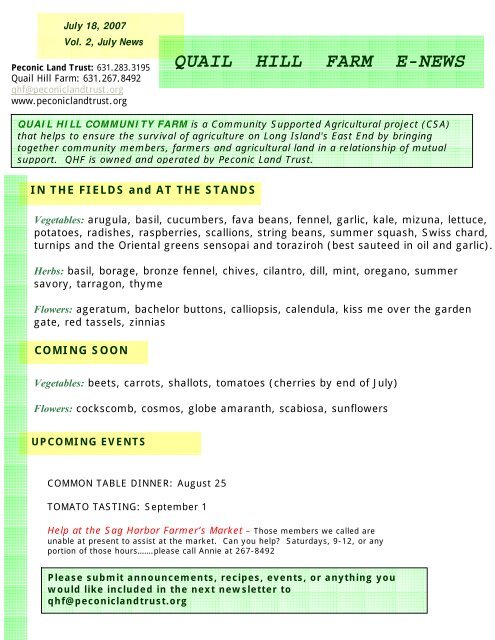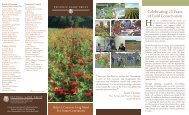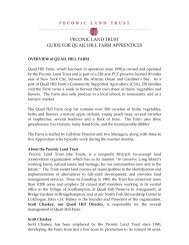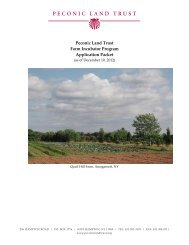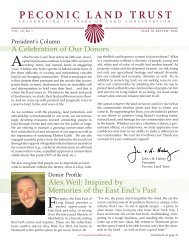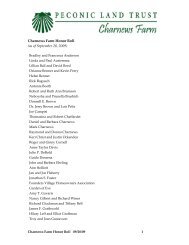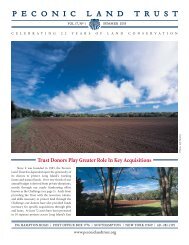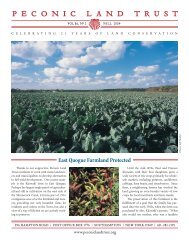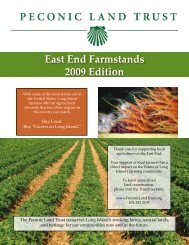QUAIL HILL FARM E-NEWS - Peconic Land Trust
QUAIL HILL FARM E-NEWS - Peconic Land Trust
QUAIL HILL FARM E-NEWS - Peconic Land Trust
Create successful ePaper yourself
Turn your PDF publications into a flip-book with our unique Google optimized e-Paper software.
July 18, 2007<br />
Vol. 2, July News<br />
<strong>Peconic</strong> <strong>Land</strong> <strong>Trust</strong>: 631.283.3195<br />
Quail Hill Farm: 631.267.8492<br />
qhf@peconiclandtrust.org<br />
www.peconiclandtrust.org<br />
<strong>QUAIL</strong> <strong>HILL</strong> <strong>FARM</strong> E-<strong>NEWS</strong><br />
<strong>QUAIL</strong> <strong>HILL</strong> COMMUNITY <strong>FARM</strong> is a Community Supported Agricultural project (CSA)<br />
that helps to ensure the survival of agriculture on Long Island's East End by bringing<br />
together community members, farmers and agricultural land in a relationship of mutual<br />
support. QHF is owned and operated by <strong>Peconic</strong> <strong>Land</strong> <strong>Trust</strong>.<br />
IN THE FIELDS and AT THE STANDS<br />
Vegetables: arugula, basil, cucumbers, fava beans, fennel, garlic, kale, mizuna, lettuce,<br />
potatoes, radishes, raspberries, scallions, string beans, summer squash, Swiss chard,<br />
turnips and the Oriental greens sensopai and toraziroh (best sauteed in oil and garlic).<br />
Herbs: basil, borage, bronze fennel, chives, cilantro, dill, mint, oregano, summer<br />
savory, tarragon, thyme<br />
Flowers: ageratum, bachelor buttons, calliopsis, calendula, kiss me over the garden<br />
gate, red tassels, zinnias<br />
COMING SOON<br />
Vegetables: beets, carrots, shallots, tomatoes (cherries by end of July)<br />
Flowers: cockscomb, cosmos, globe amaranth, scabiosa, sunflowers<br />
UPCOMING EVENTS<br />
COMMON TABLE DINNER: August 25<br />
TOMATO TASTING: September 1<br />
Help at the Sag Harbor Farmer’s Market – Those members we called are<br />
unable at present to assist at the market. Can you help? Saturdays, 9-12, or any<br />
portion of those hours…….please call Annie at 267-8492<br />
Please submit announcements, recipes, events, or anything you<br />
would like included in the next newsletter to<br />
qhf@peconiclandtrust.org
WEATHER REPORT: A Conversation with Scott by Jane Weissman<br />
Like any farmer, Scott is hedging his bets, So<br />
far, it’s been a very good year. No doubt, everyone<br />
picking in the fields will concur, harvest baskets<br />
overflowing. The weather is a major factor and having<br />
a great crew certainly has helped, too and it couldn't<br />
have been better, Scott explains. June was<br />
spectacular, sunny days, and cool breezy nights<br />
enjoyed by both people and crops. The humidity<br />
stayed low which plants like as long as they get<br />
water and we did have to irrigate a bit. All in all,<br />
excellent growing conditions. Plants have matured<br />
quickly.<br />
As many of us recall, 2006 was a tough<br />
growing year, frustrating for both farmers and share<br />
members. Not only was the weather too extreme, it<br />
constantly flip-flopped. It was either too hot or too<br />
rainy. Five-inch downpours after weeks of no rain<br />
hinders as much as it helps. According to Scott, The<br />
past few weeks have been friendly to the plants. No<br />
extremes. We had two nice rains and they were<br />
gentle enough (a half to an inch). The timing was<br />
perfect, too, providing a nice boost to the potatoes<br />
and the garlic just before it got harvested.<br />
The farmers have planted more than ever<br />
before and everything looks good. The peas had a<br />
good long run and, for those who haven’t heard, it<br />
was crows with whom we were sharing the shucking<br />
peas something Scott had never seen. It was great<br />
to see fresh garlic at the stand this past weekend.<br />
Despite last autumn’s heavy rains, which washed out<br />
a goodly number of plants, we will enjoy it for the<br />
rest of the season and there will be plenty for winter<br />
shares, too. There will just be a bit less seed from<br />
our own plants for seeding in October<br />
The early potatoes are in and it was good to<br />
literally get our hands in the dirt, a sure way to<br />
unearth even more of those delicious spuds. The<br />
farm is growing about 20 varieties, many in the Town<br />
Lane fields including some trial plants thru NOFA.<br />
One new variety is King Harry, special to Scott as<br />
Harry was his father’s name, which has hairy leaves<br />
to repel Colorado potato beetles. Good news: they<br />
came, they were conquered, they are gone.<br />
It’s a treat to have lettuce pretty continually<br />
throughout the season. There’s a patch coming<br />
along on Hurricane Hill, but as deer have on occasion<br />
made a meal of it, lettuce is also grown on Town<br />
Lane behind an impregnable deer fence. It was some<br />
of that got harvested and brought to the farm stand<br />
this past weekend, including a new variety, Cimarron,<br />
red, crunchy and delicious.<br />
The cukes are in, as early as this correspondent<br />
can remember. The Armenian variety, long, skinny<br />
and curved, a favorite, takes longer to mature and<br />
should soon be ready. The eggplants look<br />
good and are about to flower. They are a bit<br />
slow this year as they like hot weather,<br />
which only recently set in. Plus they had to<br />
fight off the beetles And the tomatoes are<br />
pretty unbelievable. Things have been going<br />
so well that the farmers had time to put in a<br />
third planting (usually not done) on Town<br />
Lane another 600-700 seedlings. And those<br />
dang crows pulled out every one of the<br />
plants. Adding insult to injury, they didn’t<br />
even bother to eat them.<br />
The farmers are already looking to fall<br />
crops. The autumn squash was seeded and<br />
has germinated nicely. Sweet potatoes were<br />
planted and they too look good. Scott<br />
explains that sweet potatoes are not related<br />
to potatoes. While both are tubers, they<br />
belong to different families. Not a<br />
nightshade (potatoes, tomatoes, eggplant),<br />
sweet potatoes are a member of the morning<br />
glory family. And what gets planted is not a<br />
seed potato (a chunk of potato with an eye<br />
or spud), but rather a root with a couple of<br />
leaves. Also sweet potatoes are not yams,<br />
even though many are marketed as such. It<br />
turns out that yams don’t even grow in the<br />
U.S.<br />
Days and days cultivating, a fancy<br />
word for weeding. The onions which will get<br />
harvested when the tops die back in early<br />
August, maybe late July, have already been<br />
hoed four times. Not too long ago, the<br />
farmers spent an entire day cultivating<br />
melons, and only just some of them.<br />
All this work is enormously helped by the<br />
efforts many terrific volunteers. Thanks always<br />
to Nick, ever ready to lend a hand. And<br />
appreciative thanks to Matt and Max, Gilda<br />
and Mel Berger’s grandsons, who are here<br />
for July and spending many days at the<br />
farm. And to Sean, and to John <strong>Land</strong>es.<br />
Recently, a group joined the farmers in<br />
weeding the raspberries, making picking for<br />
members a lot easier: Ira, Ursula and Frank,<br />
Fran and <strong>Land</strong>on, and Jane as well as Max,<br />
Matt and Sean.<br />
Happy harvesting and healthy eating!
EVENTS and ANNOUNCEMENTS<br />
POT LUCK SUPPER: July 21, 2007<br />
<strong>QUAIL</strong> <strong>HILL</strong> <strong>FARM</strong>'S 4TH ANNUAL POT LUCK SUPPER<br />
A Thank You From the Quail Hill Farm Committee<br />
We would like to thank all who came to the Pot Luck Supper last Saturday evening. Your<br />
food was glorious, your children and guests enchanting and the smore's divine!<br />
If you missed it, try to come next year and partake in some of the magic of belonging to a<br />
CSA farm community. Thanks also to the <strong>Peconic</strong> <strong>Land</strong> <strong>Trust</strong> for donating the libations and<br />
to our outstanding interns who worked all day, joined us for dinner and cleaned up after<br />
we all went home. There have been requests for copies of the recipes of the dishes served<br />
at the dinner. If you are so inclined, email Linda Lacchia lles@optonline.net and we will<br />
circulate them to members who request it. Some will be published in the next edition of<br />
this newsletter.<br />
“The Real Dirt on Farmer John”, Saturday, August 1<br />
A superb, award winning documentary about an Illinois farmer whose home farm has been<br />
transformed into a dynamic CSA and learning center will screen at the Sag Harbor Cinema.<br />
Scott has traveled with this colorful character and recommends the experience!<br />
For the real dirt on Farmer Scott tune in to WLIU, 88.3, Wednesdays at around<br />
8:30 a.m., “In the Morning” (Nature: news and views).<br />
TOMATO TASTING: September 1, 2007<br />
the 10th annual<br />
GREAT TOMATO TASTE OFF<br />
Saturday, September 1, 2007: 9-12 in The Apple Orchard<br />
Taste and rate the 50 varieties of tomatoes grown at Quail Hill Farm. Cherries, paste,<br />
standard. Red, pink, yellow, orange, purple and green. This year, the farm has planted 21<br />
new varieties. Let's see how they stand up to our favorites.<br />
A fact sheet with descriptions of all the varieties will soon be at the farm stand.<br />
Volunteers are needed!<br />
To harvest on Friday and run the event on Saturday!<br />
Watch the farm stand for a sign up sheet.<br />
Or contact Jane: urbecoart@aol.com, 212.989.3006<br />
To help offset event costs and to generate revenue<br />
(which helps keep share prices down) we are charging:<br />
$10 nonmembers<br />
$5 members (suggested contribution),<br />
Free: kids under 12
THE APPRENTICE: Meet ANNA<br />
When I was asked to include the scone recipe I baked for the Opening Day Farm Breakfast in the July newsletter, a fitting<br />
theme came to mind for my newsletter introduction to you.<br />
When Brett and I came to work at the farm, something happened for me that resulted in a new focus on food: we always liked<br />
eating well, but now we think about food all the time. The change could be something as simple as the transition from<br />
sitting in a chair all day to doing farm work increasing our appetites. But more than that, I think what happened really was<br />
that at some point I realized that when we farm, we are making food all day long.<br />
Pruning raspberry canes is making jam, seeding lettuce becomes making salad, cutting seed potatoes isn’t that far from<br />
mashing potatoes. I don't know why the connection between daily farm work (and not just the end point of harvesting) and<br />
meals was elusive to me for so long, but it was exciting to realize the connection in full force, to grasp what a special thing it<br />
is to be able to feed people.<br />
At work our conversation frequently turns from crops to the subject of food – what to do with various vegetables, what to eat<br />
for lunch, and what was eaten for dinner the night before. I have discovered how many serious food people have been<br />
attracted to the farm. Foodies, a group I never would have thought to associate myself with in my pre-farm life now doesn’t<br />
seem so far-fetched a way of describing what I am involved. Lately, Brett and I have been reading aloud recipes from<br />
magazines or cookbooks, questioning one another on the techniques and ingredients as a sort of guessing game. I find myself<br />
wondering how and why I have made do for so long without such things as a food processor or a bundt pan.<br />
If farming vitalizes one’s relationship with food, then cooking seems equally to encourage recipes.<br />
The scone recipe I used for the opening day breakfast is from The Foster's Market Cookbook, but with my own tweaks in the<br />
version printed here. Aside from a few trial batches before the breakfast, I had never made scones before. I'm not sure that<br />
I did things exactly the way scones are "supposed" to be made, but this is what I ended up with as my favorite. I will warn you<br />
though: scones are a pain to make. But following these directions should get you a decent scone. Don’t give up at the point<br />
when you have a sticky buttery blob: they will bake just fine.<br />
Scones<br />
4 ½ cups flour<br />
½ cup sugar<br />
2 tsp baking powder<br />
½ tsp baking soda<br />
½ tsp salt<br />
3 sticks cold unsalted butter cut into ¼ inch pieces<br />
1 ¼ cup plus 2 tablespoons buttermilk<br />
Optional: ½ cup dried fruit, set in lukewarm water for a few minutes. For fresh fruit like raspberries add 2 cups and use 2-3<br />
tablespoons less buttermilk. For adding rhubarb toss it first in sugar and sprinkle the top of the scone with cinnamon sugar.<br />
Egg wash: 1 egg beaten with 2 tablespoons milk.<br />
1. Preheat oven to 400 degrees.<br />
2. LIGHTLY grease 2 baking sheets and set aside.<br />
3. Combing flour, heaping ¼ cup sugar, baking powder, baking soda, and salt in a large bowl.<br />
4. Add the cold butter to flour mixture and cut in using pastry cutter until the mixture resembles a coarse meal (sort of<br />
likr rolled oats) or pulse in a food processor 10-12 times. Do not overwork dough or allow the butter to get soft,<br />
return to fridge if it’s too warm.<br />
5. Add 1 ¼ cup buttermilk (some recipes call for half-and-half, but buttermilk which is lower in fat makes the scones<br />
lighter and flakier) and mix until just combined and the dough begins to stick together. Add the remaining buttermilk<br />
one tablespoon at a time if the dough is too dry. Note: if adding fruit fold in now.<br />
6. Turn the dough out onto a lightly floured surface. Note: the dough will probably look like a mess at this point, shaggy<br />
and not very cohesive, but as you pat it into two 6 inch circles about 1 ½ inch thick it should come together. The<br />
dough will probably be sticky because of the butter, try not to have too much contact because that will make the<br />
butter melt into the batter. Cut each round into six pie wedges. Use a spatula to lift the wedges to the lightly<br />
greased baking sheet.<br />
7. Brush tops with egg wash and sprinkle top with scant ¼ cup sugar.<br />
8. Bake 30-35 minutes, until golden brown and firm to tough. Cool on a baking rack.<br />
NEXT ISSUE: Meet Joe & Annie
CROSSWORD PUZZLE: by John de Cuevas<br />
Wrap-around Crossword Puzzle - by John de Cuevas<br />
Instructions: So lve this puzzle the<br />
way you would any normal crossword<br />
puzzle but notice its unusual features.<br />
Words wrap around. That is, across<br />
words that don't end at the right<br />
continue on the next row, and down<br />
words that don't end at the bottom<br />
continue in t he next column. What's<br />
more, four across words and four down<br />
words (their clues are marked by an<br />
asterisk) won't fit in the grid unless<br />
one of the ir letters is removed. Those<br />
eight letters, taken in the ord er they<br />
occur in across and down words, spell<br />
a two-word phrase that defines the<br />
mystery entries. (If you like this puzzle<br />
and want to see others like it, visit my<br />
website, www.puzzlecrypt.com, but be<br />
warned, the puzzles on the site are<br />
much more difficult than this one.)<br />
1 2 3 4<br />
5 6 7 8<br />
9 10 11 12<br />
13 14 15<br />
16 17<br />
18 19 20 21 22<br />
23 24<br />
25 26 27 28 29<br />
30 31 32<br />
33 34<br />
35 36 37<br />
Across<br />
1. Mystery entry<br />
3. Song<br />
4. Flower<br />
6. Cultured milk<br />
9. Aggregate<br />
11. Tradesman<br />
13. *Treat with partiality<br />
14. Cries<br />
15. Potato, for instance<br />
16. Do again<br />
17. What farmers do to soil<br />
18. Post<br />
20. Milk curd<br />
23. *Dog<br />
24. Revolve<br />
25. Shirker<br />
27. Italian poet of the 16th century<br />
30. Pleasantry<br />
31. Lake or tarn (uncommon word)<br />
32. Nobleman of low rank<br />
33. *Fruits<br />
34. Coffin carrier<br />
35. *Obstruct<br />
37. Mystery entry<br />
Down<br />
1. Good Samaritan<br />
2. Having distinction<br />
3. Swine<br />
4. Mystery entry<br />
5. *Farmer's tool<br />
7. Festive occasion<br />
8. Northern Ireland<br />
10. Bleaching agent<br />
11. Use up<br />
12. Choose<br />
16. What farmers need now and then<br />
18. *Aquatic mammal<br />
19. *In a fervent manner<br />
21. Manage with economy<br />
22. *Support<br />
23. Pointed end<br />
26. Enzyme produced by the kidney<br />
28. Theater<br />
29. Hindu garment<br />
30. Mystery entry<br />
31. Lady in charge<br />
34. Nimbus<br />
36. Minister<br />
Copyright 2007. John de Cuevas. All rights reserved.
CROSSWORD PUZZLE SOLUTION : by John de Cuevas<br />
(for the June Puzzle)<br />
F A R M Q U A I L H I L L<br />
E P E E U N C L E E R I E<br />
T E A L O D I L E R A N T<br />
E X P O R T E D B R A N D O<br />
D O E R S O U L<br />
R E M I S S S T A N D A R D<br />
E R I C A S P O R T S C A R<br />
A R A A W A R D O N O<br />
C O M M U N I T Y C A R G O<br />
T R I A N G L E G U N N E D<br />
T I L L S O R T<br />
R E F U T E S C A L A W A G<br />
O M A R P I C O T C A N E<br />
M I R E O R A T E I C O N<br />
P L O D D A N T E D O N E
OF OTHER INTEREST<br />
EDIBLE FLOWERS<br />
by Jane Weissman<br />
Many flowers at Quail Hill Farm are edible: a few ornamentals as well as the<br />
blossoms of some vegetables and herbs. They can go into salads and/or used<br />
for garnish. Some can be fried up. Put herb and greens flowers in a jar of water<br />
-- they look great on a kitchen windowsill -- until you need them. Every day or<br />
so, change the water and snip the ends to keep them fresh.<br />
ORNAMENTALS:<br />
Calendula and Nasturtium petals provide lovely color and a hint of spice.<br />
VEGETABLES:<br />
When Broccoli Raab, Mizuna, and Arugula go to seed or bolt, they produce an edible<br />
flower. Like their leaves their flowers are a bit peppery. Cut the stems long and<br />
keep them in water. Pinch off the freshest flowers when you’re ready to use<br />
them.<br />
If you’re frying up Zucchini flowers, try stuffing them with basil leaves or a half<br />
teaspoon of goat cheese or gorgonzola dolce before dipping them in a flour and<br />
water batter. Add ground black pepper and/or hot pepper flakes to the batter for<br />
a little zing. Sprinkle salt over the fried blossoms.<br />
HERBS:<br />
In June, try Chive flowers. Just pull apart the small flowers that make up the<br />
purple globe. Also, try frying up unopened Sage flowers. Cut the stalk to include<br />
the buds and three or four pairs of young leaves. Until Dill flowers go into a<br />
pickling brine, they are lovely in bouquets. Down in the valley, Borage is growing<br />
between the rhubarb and raspberries. The nodding blue flowers taste a bit like<br />
cucumbers, very nice in salads. Stick three or four Lavender blossoms in a cup of<br />
sugar and let stand overnight. Then use the sugar for baking pound cake or<br />
shortbread.<br />
THE GOODNESS OF GARLIC<br />
This appeared in Gourmet Weekly on June 28, 2007:<br />
Garlic is good for you. But you don't need me to tell you that. What you might<br />
not know is that chopping garlic releases its cancer-fighting properties, but<br />
cooking it kills them. At least, cooking it right away. A new study by the<br />
American Institute for Cancer Research shows that when chopped garlic is<br />
allowed to rest for ten minutes before heating, it retains most of its anticancer<br />
protection. For lovers of the stinking rose, this is very good news. From now on,<br />
make chopping garlic the first thing you do when you start cooking. You'll have<br />
good taste and good health. —Ruth Reichl
THANK YOU<br />
<strong>FARM</strong> BREAKFAST<br />
Breakfast is a notoriously difficult meal to serve with a flourish.<br />
-- Clement Freud<br />
Thanks to a great group of volunteers, the 11th annual farm breakfast on Saturday, June 23 -a<br />
beautiful, sunny, not too hot day -- was a perfect affair.<br />
Jane who organized the breakfast extends BOUNTIFUL THANKS (in more or less the order of<br />
making the breakfast happen) to:<br />
On Friday (and before)...Scott (who also did the coop order) and farmers Joe, Brett, Anna and Annie who<br />
mowed the orchard, picked rhubarb, transported kitchen set up, tables and packing crates, and...<br />
... Nick for helping to set up the Apple Orchard.<br />
PLT's Laura Fischer and Pam Greene for daily ongoing assistance.<br />
Alice Kaltman and Katy Brennan who washed coffee pots, mugs, bowls and all the farm's<br />
harvesting containers, transforming them into sparkling compost and recycling bins.<br />
Robert Schwagerl who over the years has turned our cooking space into a sleek, efficient outdoor<br />
kitchen -- a long way from those first breakfasts turned out on a couple of backyard gas grills.<br />
Pauline Yeats and Judy Freeman for making the strawberry rhubarb compote.<br />
Jo, Patty and Peachie at the Green Thumb in Water Mill for selling us potatoes and onions at cost. And<br />
Ronnie Grill, Susan Cook and Lindsay Morris for roasting the potatoes. And Gordian and Gabriele Raacke,<br />
with a peeling assist from Bettina Volz and Don Lenzer, for making the onions.<br />
Ursula Lee and Liadain Smith for harvesting the herbs for the potatoes and eggs.<br />
The Iaconos whose hens were prolific enough to supplement Quail Hill eggs altho this year farm<br />
hens produced all the eggs we needed.<br />
And on Saturday...Early arrivals (6 a.m. onwards) Martha Sutphen, Susan C., May Kuckro, Francesca J, Nick,<br />
Gordian, Kevin Coffey, Carla Ash and Jerry Pluenneke for setting up on Saturday morning.<br />
Dorothy Donovan, Johanna Ellner, Linda Lacchia, Jonathan Groffman, Martha Sutphen, Gabriele and Bettina<br />
who staffed all the tables: breakfast admission, utensils, books,and t-shirts, mugs, At the<br />
Common Table info and the QHF membership raffle.<br />
Kevin C. who kept Robert and Gordian in pancake batter and Chris Schwagerl who joined the merry<br />
band.<br />
Jane Umanoff, Susan C., Kathy Masters, and Hilary Leff who made the softest, tastiest eggs and<br />
reheated the potatoes, and Bernadette Costanzo who performed admirably as sous chef.<br />
Thanks to Linda L. and Linda Golden and the unknown baker of those marvelous scones for<br />
supplying the muffin table. (Next year, more baked goods, please and thanks.)<br />
Sean Mulligan, Susan Taylor, Doug Mucaire, Steve Frankel and Gardner Frankel who joined the clean-up<br />
crew -- Gordian, Scott, Nick, Kevin and Kathy, and many more -- transporting supplies, compostibles<br />
and recyclables to the farm shop and washing the coffee cups and pots.


